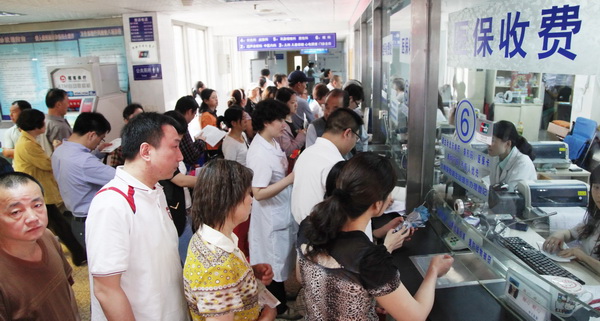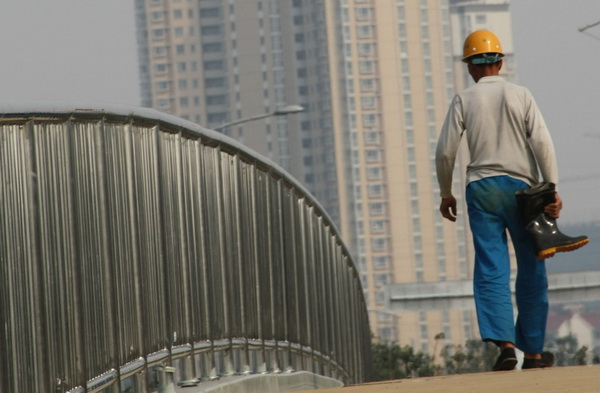

Highlights from the EO print edition, No. 619, May 13, 2013
China Breaks the Ice on Soil Protection Legislation
News, page 1
~ Legislation on environmental protection of soil has finally made progress. The first draft of the Soil Protection Law, jointly formulated by eight ministries including the National Development and Reform Commission (NDRC), the Ministry of Land and Resources (MLR), the Ministry of Industry and Information Technology (MITT) and the Ministry of Agriculture, has been completed. Over the next few years, China will revise its environmental standards for soil and toxic substances.
~ China’s soil pollution is mainly found in rural farmland and urban industrial land. In 2010, one-fifth of China’s farmland was polluted. However, no one except the government knows the exact soil pollution figures.
~ A source familiar with the issue told the EO that the Ministry of Environmental Protection invited some representatives who were interested in the legislation process to a symposium at the end of April. During the symposium, the government introduced China’s current soil situation and measures that will be taken for soil protection in the future.
~The source also said the soil protection law wasn’t included in the State Council’s legislation plan for 2013, so it won’t be introduced this year. If everything goes well, it may be included next year.
Original article: [Chinese]

Pilot Medical Reform Wins Praise in Wuhan
News, page 5
~ Recently, at a public hospital reform forum, Wuhan’s system for patient referral and doctor incentives won widespread recognition among experts and hospital directors.
~ The Fifth Hospital of Wuhan is the only first-class hospital in Hanyang County, and thus, it’s always overcrowded with patients. People have little trust for the surrounding community clinics, so they tend to travel to the very best hospital, even for very minor problems. The result is an overcrowded Fifth Hospital and empty community clinics.
~ The Fifth Hospital tried recruiting 50 specialist doctors from community clinics and trained them for three years to be general practitioners with the hope that more people would go to them. But there was still a problem with incentives. They were paid both by the Fifth Hospital and the community clinics regardless of how many patients they saw or how well they performed. Thus, they just assumed sit idle and patients continued to flock to the Fifth Hospital.
~ Zhang Bin (张斌), director of the Fifth Hospital, came up with the idea to divide the salary of clinic doctors into two parts. 70 percent is related to performance, including things like the number of patients they see. The other 30 percent is related to their attitude with patients and the number of complaints received. This has increased the enthusiasm for doctors at community clinics.
~ The Fifth Hospital has begun to delegate outpatient treatment, recovery and internal medicine to community clinics. But after surgeries and other major procedures at the Fifth Hospital, the doctors there still follow up on patients’ recovery at the clinics.
~ Now first-class hospitals and community centers in other regions have begun to assign their patients to different levels of hospital according to their conditions.
Original article: [Chinese]

Turning Rural Migrant Workers into Urban Residents to Cost 1.8 Trillion Yuan
News, page 6
~ It would cost the Chinese government at least 1.8 trillion yuan if they tried to in one go settle the 160 million rural migrant workers that travel outside their home province in search of work in cities, according to a new report from researchers at the Chinese Academy of Governance.
~ However, this 1.8 trillion yuan figure only refers to the costs of providing these internal migrants with basic public services, including education, heath care, a minimum living allowance, housing and pension support, said Feng Qiaobin (冯俏彬),one of the authors of the report.
~ "It works out at about 15 percent of government spending included in the national budget," said Feng. "But annual government spending on social security is now about 1 trillion yuan, or about 11 percent of budget outlays."
~ The report makes the argument that government spending on such services for migrants needs to be shared by central and local governments, as well as by governments in areas that receive new migrants and those that are seeing an outflow of residents.
~ If the urbanization process is spread out over the coming eight years from 2013 to 2020, the costs of providing such services would increase by about 200 billion yuan each year. The total expenditure over the eight year period would be well in excess of 1.8 trillion yuan.
~ Considering the overall economic development and financial conditions in China, the key is to establish a transfer payment system which can coordinate funding levels across governments in "inflow" and "outflow" areas.
~ The Ministry of Finance (MOF) is said to be conducting research into the fiscal spending required to fund urbanization, focusing specifically on how much money will be required to offer basic public services to new migrants.
Original articles: [Chinese]
Shenzhen's Renewable Energy Push
Nation, page 12
~ Shenzhen's Gross Domestic Product (GDP) reached 1.29 trillion yuan at the end of last year, an increase of 10 percent over the previous year. Among the city's strategic emerging industries, added value created by the renewable energy industry reached 32.53 billion yuan in 2012, an increase of 19.8 percent year on year.
~ Beginning in 2010, the Shenzhen government promised to provide 500 million yuan a year in subsidies to the renewable energy sector for 5 years. The city wants to grow the sector into a 250 billion yuan industry, with renewable energy vehicles leading the way.
~ "The impact of the constant expansion of renewable energy vehicles in terms of energy conservation and emission reductions is increasingly evident," said Lu Xiangzhen (陆象帧), a deputy inspector in a major project office of Shenzhen Development and Reform Commission. "Hybrid buses are saving energy at an average rate of 15 percent, and the amount of energy consumed by pure electric vehicles is only one third of that of conventional fuel vehicles."
~ At the same time, Shenzhen has built 62 different types of charging stations, of which, 57 are bus charging stations and 5 are public charging stations. The number of slow charging piles in residential areas and parking lots has reached 3,000.
~ As a national low-carbon pioneer city, Shenzhen has established the China Shenzhen Emissions Exchange (排放权交易所). The city government announced in 2012 that trading on the exchange would begin in 2013.
~ Du Jun (杜军), the general manager of Shenzhen's Pengcheng Taxi Company (深圳鹏城出租车公司), told the EO that there are approximately 16,000 taxis and 10,000 buses in Shenzhen, discharging about 500,000 tons of carbon dioxide each year. Although buses and taxis account for only 1.7 percent of the total number of motor vehicles in China, they account for about 25 percent of total fuel consumption and 30 percent of total emissions.
Original article: [Chinese]
Enlight Media Sees Another Major Success with So Young
Market, page 22
~ On May 8, Enlight Media announced that the box office take for So Young (致青春) had exceeded 520 million yuan after playing for 12 days. The film cost 60 million yuan to make, 20 percent of which was paid by Enlight.
~ “Nostalgic and youth-oriented movies have catered to the social psychology and atmosphere of this period of social transformation,” said a securities dealer in an analysis report on Enlight Media. “So Young will bring more popularity to this type of movie thanks to the popularity of [famous actress] Zhao Wei (赵薇) and the marketing from Enlight Media.”
~ Enlight invests in, produces and distributes television programs and films. In the past, the company has focused mostly on television, but in the latest fiscal year audit, films accounted for half of the company’s revenue.
~ Enlight Media President Wang Changtian (王长田) said that the company will make profit on So Young both through its investment in production and distribution. If the movie makes 800 million yuan, then Enlight will make a total profit of about 70 to 80 million yuan.
~ Thanks to the high box office return on So Young, Enlight Media’s share price has increased by 70 percent in one month and its market value has exceeded 15 billion yuan. It now rivals the size of Huayi Brothers (华谊兄弟), another major Chinese film studio.
~ Enlight Media was just coming off the heels of another major (and unexpected) success with the film Lost in Thailand. That movie yielded 300 million yuan on a budget of just 30 million.
Original article: [Chinese]
Lenovo Seeks Future in Blueberries
Corporation, page 32
~ On May 8, Legend Holdings Ltd., the parent company of Lenovo, unveiled its new agricultural brand Joyvio (佳沃). For Lenovo, the world famous PC vendor, entering the agricultural industry is a bold move. After investing over one billion yuan, Legend Holdings has become China’s biggest blueberry supplier with 20 percent market share.
~ Chen Shaopeng (陈绍鹏), the head of Joyvio, used to be the vice president of Lenovo’s business PC sector. In agriculture, the biggest risks come from changing weather and slow information flow about shifting supply and demand. To confront these risks, Chen has developed a digital strategy to “make all information traceable, take part in the whole industry chain and reach around the globe.”
~ “There are no windfall profits in agriculture,” Chen said. “But it’s a booming industry. Woody fruits are long-term investments. It takes five to seven years for the plants to reach the output standard.” He also said Legend Holdings would keep increasing investment.
~ Joyvio has introduced remote satellite sensing for use in managing farms. GPS has also been installed on spraying carts to ensure that pesticide is well distributed.
~ Every box of blueberries from Joyvio has a barcode that allows you to trace its history. Chen believes that people’s need for quality fruits will ensure success of their products.
Original article: [Chinese]


